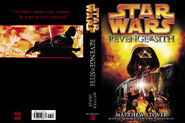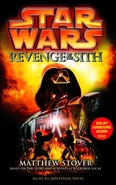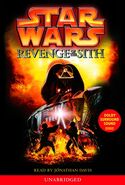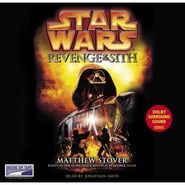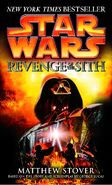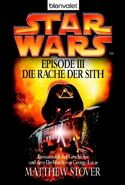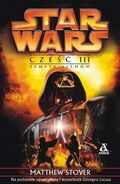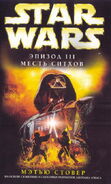Template:Infobox Book The Star Wars Episode III: Revenge of the Sith novelization was written by Matthew Stover and published on April 2, 2005 by Del Rey. It is based on the script of the movie of the same name. Narration for the audio version was performed by Jonathan Davis.
The book's plot corresponds almost exactly to that of the movie, though there are several added elements not seen in the film (the appearance of Lorth Needa as commander of the Integrity during the Battle of Coruscant, for example), while several sections of the movie's plot (most notably the Kashyyyk sequence) have been removed for the sake of the story's pacing. All of the deleted scenes with the founders of the Rebel Alliance are included, and Stover heavily references the previous chronological novel, James Luceno's Labyrinth of Evil, something uncommon in film novelizations.
Editions
American
- ISBN 0345428838; April 2, 2005, Del Rey, 432-page hardcover
- ISBN 0345485564; April 2, 2005, Del Rey, 432-page slipcase edition hardcover
- ISBN 0739301861; April 2, 2005, Random House Audio, Abridged cassette (5 hours and 2 minutes)
- ISBN 0739318314; April 2, 2005, Random House Audio, Abridged CD
- ISBN 0739318322; April 2, 2005, Random House Audio, Unabridged cassette
- ISBN 0739318330; April 2, 2005, Random House Audio, Unabridged CD
- ISBN 141591673X; April 2, 2005, Books on Tape by Random House Audio, Audio CD
- ISBN 0345428846; October 25, 2005, Del Rey, 480-page paperback
Foreign
- ISBN 8324121269; Amber, 367-page Polish paperback (Zemsta Sithów)
Publisher's summary
Hardcover
Back cover
"The Force grows dark, Anakin.…
Be wary of your feelings."
Inside flap
The turning point for the entire Star Wars saga is at hand…
After years of civil war, the Separatists have battered the already faltering Republic nearly to the point of collapse. On Coruscant, the Senate watches anxiously as Supreme Chancellor Palpatine aggressively strips away more and more constitutional liberties in the name of safeguarding the Republic. Yoda, Mace Windu, and their fellow Masters grapple with the Chancellor's disturbing move to assume control of the Jedi Council. And Anakin Skywalker, the prophesied Chosen One, destined to bring balance to the Force, is increasingly consumed by his fear that his secret love, Senator Padmé Amidala, will die.
As the combat escalates across the galaxy, the stage is set for an explosive endgame: Obi-Wan undertakes a perilous mission to destroy the dreaded Separatist military leader General Grievous. Palpatine, eager to secure even greater control, subtly influences public opinion to turn against the Jedi. And a conflicted Anakin—tormented by unspeakable visions—edges dangerously closer to the brink of a galaxy-shaping decision. It remains only for Darth Sidious, whose shadow looms ever larger, to strike the final staggering blow against the Republic…and to ordain a fearsome new Sith Lord: Darth Vader.
Paperback
The turning point for the entire Star Wars saga is at hand…
As combat escalates across the galaxy, the stage is set for an explosive endgame: Obi-Wan undertakes a perilous mission to destroy the dreaded Separatist military leader, General Grievous. Supreme Chancellor Palpatine continues to strip away constitutional liberties in the name of security while influencing public opinion to turn against the Jedi. And a conflicted Anakin fears that his secret love, Senator Padmé Amidala, will die. Tormented by unspeakable visions, Anakin edges closer to the brink of a galaxy-shaping decision. It remains only for Darth Sidious to strike the final staggering blow against the Republic—and to ordain a fearsome new Sith Lord: Darth Vader.
Excerpt
Notable differences between the movie and the novel
Battle of Coruscant
The battle sequence is expanded in the book, and detailed descriptions of a small number of maneuvers are included, such as the Slip Jaws maneuver. Also, the damage caused to Obi-Wan's fighter by the Buzz Droids is much more severe, to the point where his ship has lost all maneuverability. Also, R4-P17 is mistakenly listed as male, when, in fact, she has feminine programming.
Duel with Count Dooku
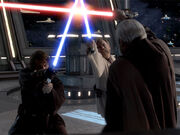
Duel with Dooku.
While the duel between Anakin, Obi-Wan, and Count Dooku is relatively short in the movie, its appearance in the novelization depicts it as the longest one in the story. Added elements include Dooku using the Force to fling chairs and tables against the two Jedi.
Before the duel itself, there is a short conversation between Palpatine and Dooku, revealing the plan which Palpatine used to lure Dooku into the confrontation with his new candidate for apprenticeship. This was the first scene ever to appear in the novelizations which confirms that Darth Sidious and Palpatine are the same individual.
In the novel, Dooku is depicted as being clearly overpowered by the Jedi, with both Obi-Wan and Anakin being nearly as powerful as he is. He panics and spends most of his energy to take out Obi-Wan before Anakin kills him.
After Dooku is disarmed and Palpatine urges Anakin to kill him, it becomes obvious for Dooku that he had been used as a pawn and a decoy, who never possessed the true powers of a Sith. His last thought was, "Treachery is the way of the Sith".
Also, Anakin's guilt at having killed Dooku in cold blood lasts much longer than in the movie.
Anakin and Padmé
In the novelization, we get to glimpse more of the tragic couple’s relationship and how it headed so rapidly toward its downfall. The scene where Padmé tells Anakin she is pregnant is extended:
Today, here in the hallway of the Senate Office Building, she brings him news of a gift they have given each other - a gift of joy, and of terror. This gift is the edge of a knife that has already cut their past from their future.
In another example, the book also includes a scene in which Anakin and Padmé discuss the gender of the child she carries, believing at the time that she was only pregnant with a single child. Anakin is adamant that the baby is a girl, due to its forcible kicks, whereas Padmé is certain it is a boy, due to her motherly intuition. Although this may not seem like a scene that broadened and shortened Anakin's path to the dark side, it shows his love and devotion to his family, highlighting the fact that he would do any thing for them, including becoming a Sith Lord.
A subplot where he is jealous of Obi-Wan and suspects that Padmé is being unfaithful to him with the latter. Palpatine further feeds this fear in him, driving the couple further apart and adding to Anakin's confused emotional state which will eventually result in him turning to the dark side.
C-3PO
The book presents more of C-3PO's thoughts regarding events, including a scene of 3PO allowing Obi-Wan into Padmé's apartment, though the droid was wary of Kenobi. His talk with R2-D2 before Anakin left for Mustafar was also expanded, with 3PO telling R2 rumors about what was happening. Additionally, Bail Organa's decision to have C-3PO's mind wiped is given more context, in light of the droid's obvious inability to keep sensitive information (in this case, about the Skywalker twins true parentage) to himself (in contrast with R2-D2).
General Grievous
In the book, Grievous lacks the sickly cough and is described as virtually unbeatable. He is also described as being unable to laugh, which he did in the film. However, he does fear both Anakin and Obi-Wan, who he notices are much deadlier than any other Jedi he has faced. During the duel with Obi-Wan, Grievous finds himself completely outmatched. When Obi-Wan and Grievous fight on the landing platform, Obi-Wan is able to severely damage Grievous's limbs simply by using the Force.
Grievous' true emotions about the Neimoidians are also revealed in the novel. He quickly becomes annoyed with them, constantly wishing he could remove their brains. Nute Gunray and Rune Haako are only safe from Grievous' "grip" due to Darth Sidious' protection over them. The bridge crew of Invisible Hand is not so lucky, though; Grievous kills all of them.
The Neimoidians on General Grievous's flagship
General Grievous kills almost all of the Neimoidians on board the Separatist flagship, either because of the annoyance they caused, or because they failed to complete their assigned tasks. The casualties presumably included Lushros Dofine, although none of them are identified by name. Those who were not killed by Grievous absorbed randomly deflected blaster bolts from the Droidekas that had been deployed to kill Anakin and Obi-Wan. This is in direct contrast to the film's version of the bridge scene, wherein Grievous simply tells the crew to keep the ship in orbit before leaving the vessel; during the flagship's crash-landing the Neimoidians are shown fleeing the bridge, apparently alive and well.
The departure of the Separatist Council
In the film, Obi-Wan overhears Grievous briefing the Separatist Council about their new hideaway on Mustafar before they depart in front of Kenobi's eyes. In the book, the Council departs days before Kenobi's arrival. Grievous witnesses them frightfully scurry onto their starship.
In addition, Nute Gunray stays behind for a few minutes to discuss the safety of the Council and financial problems of himself and the other Confederacy leaders before departing.
The Battle of Kashyyyk
The Battle of Kashyyyk is completely absent from the novel. Luminara Unduli, Quinlan Vos, Chewbacca, Tarfful, and Commander Gree do not appear, nor are they mentioned. The book does explain why Yoda went to Kashyyyk in the first place, however: it was an attempt to lure Darth Sidious out of hiding. Palpatine was allegedly manipulating the Jedi into isolating Anakin from his two closest mentors—Obi-Wan and Yoda—before tempting him with the power of the dark side.
Palpatine tests Anakin's thirst for power
Palpatine offers to give Anakin anything he wants. At first, Anakin wonders if the Chancellor is only playing a childish game with him. He wishes for a new speeder, although this was probably meant as a test of how serious Palpatine was being at the time. Palpatine asks if this is all he wishes, and the 'game' escalates until Corellia is mentioned. Sidious asks him if he wishes only the planet or the entire system. Anakin told him he wanted the whole system. The point of this game is to strengthen Palpatine's assertion that the Jedi hold Anakin back, and that he must choose for himself (a Sith idea, as it focuses only on what he wants) what he desires, "letting himself out", as Palpatine puts it. It also represents the length to which Palpatine is willing to go for his future apprentice; it is clear that he would, in fact, have given Anakin the entire Corellian sector had he so desired.
The arrest of the Chancellor
In the novelization, Mace Windu contacted Yoda once more after learning the truth of Palpatine's identity, sanctioning his upcoming decision and action with the approval of the Grand Master of the Jedi Order.

Darth Sidious's lightsaber.
The novelization stated that Darth Sidious could indeed sense the approach of the four Jedi Masters, as well as the emotional turmoil of Anakin Skywalker, who was still waiting in the Council Chamber. The novel also described Palpatine's preparations for the upcoming duel in detail, including how he recovered his Sith lightsaber and prepared an audio recording.
During the duel, Saesee Tiin was beheaded when Sidious tricked him and caught him off guard. Agen Kolar was then impaled through the head by Palpatine's lightsaber.
Anakin Skywalker, recognizing the consequences of what he did by revealing Palpatine, rushed to the Chancellor's office. Shaak Ti stood in his way and tried to convince Anakin not to go, but Anakin rudely refused to obey the Jedi Master.
As he arrived, he witnessed the battle between Kit Fisto, Mace Windu, and Palpatine by hovering his speeder outside Palpatine's office window. He could not yet determine who the combatants were, seeing only their lightsabers. When the green blade flicked out, he smashed the window to Palpatine's private office and leapt through. There, he found the dead body of Kolar and the heads of Saesee Tiin and Kit Fisto. Anakin was able to watch the epic lightsaber duel between Windu and Palpatine for some time, instead of arriving just in time when the Jedi knocked down Sidious in the movie.
Duel with the Chancellor.
Mace Windu could sense the approach of Anakin through the Force before he broke the office window, so it was reasonable for Darth Sidious to have the same experience. When the fight moved to the ledge, Mace described sensing Palpatine's momentary hesitation as the Sith Lord decreased his speed.
Whether it was an intentional trick on the part of Palpatine or whether Windu truly out-sparred the Sith Lord is confirmed in neither the movie nor the novel. Mace confessed, however, that Vaapad could not overpower the Sith Lord, and it was his shatterpoint ability which allowed him to gain the upper hand. In the book, Mace Windu did not kick Palpatine's jaw, and he sliced the Chancellor's weapon in half rather than knocking it from his grasp.
When Mace held Palpatine at blade point, he explained to the Sith Lord why Darth Sidious and his shadowy order always lose: because they were always defeated by their own fear. Palpatine countered by screaming "Fool! Do you think the fear you feel is mine?" and blasted the Jedi Master with Force lightning.
In the fight, Mace Windu realized that Palpatine's shatterpoint was Anakin Skywalker himself. When Anakin approached Mace, who was struggling to deflect the lightning blasts, Mace sensed that Palpatine did not fear Anakin at all, and that the Sith Lord would make no move to defend himself. Mace concluded that this was the shatterpoint of the Sith, and the absolute shatterpoint of the dark side itself.
Ultimately when Mace was betrayed by Anakin and blasted by Darth Sidious, he came to the shocking realization that although Anakin Skywalker indeed was the shatterpoint of Darth Sidious, he forgot to look for the shatterpoint of Anakin himself: his desire to save his wife at any cost.
Order 66
Order 66 was described in a few short sentences, with no mention being given of any specific Jedi's death or identifying any clone commander who executed the order. Only Obi-Wan's scene was the same as seen in the movie, except for the fact that Cody ordered more than one AT-TE to fire at Kenobi. Yoda's case was not described either, and he next appears when he meets Obi-Wan on board the Tantive IV.
The Jedi Temple under attack
When Darth Vader arrives in the Jedi Temple with the 501st, it is described how he killed some Jedi, including the gatemaster Jurokk.
In the book, Matthew Stover provided the reasons why the Clone War was being fought in the first place, describing it as "the perfect Jedi trap", a concept introduced earlier in the novel as Obi-Wan arrives on Utapau. This is the first account of the full extent of Sidious's plotting.
The return to the Jedi Temple
In the novel, it is better described how Obi-Wan and Yoda avoided attention in the Temple. Cin Drallig is mentioned as Obi-Wan's fencing instructor, after seeing his corpse lying on the ground.
Slaughter of the Separatist Council
The mission to Mustafar is depicted somewhat differently in the novel than in the movie. In the film, Nute Gunray greets Vader before the massacre begins. In the novelization, San Hill greets Vader before being killed. In addition, all those depicted dying in the novel save Poggle the Lesser due to a language barrier speak, whereas only Nute Gunray speaks in the film.
The leaders also die in a different order than in the film: San Hill, Poggle the Lesser, Shu Mai, Wat Tambor, Rune Haako, and finally a pleading-for-life Nute Gunray. Passel Argente and Po Nudo are not depicted dying in the novel, while both are seeing running from Vader and being sliced down shortly after in the film. None of the aides beside Rune Haako are mentioned either.
Emperor Palpatine vs. Yoda duel
In the novel, it became clear that Darth Sidious was indeed superior to Yoda. Yoda also realized that the Jedi Order mistakenly focused on fighting the old Sith rather than the new, evolved Sith of Darth Bane's order. Yoda described that "he had lost before he started. He had lost before he was born." However he was able to learn a new insight "which held the hope of the galaxy" during the battle.
In the book, Yoda entered the Chancellor's holding office from a different direction, so the Royal Guards did not attempt to stop him and Mas Amedda left the office before any exchange was made. Palpatine's Force lightning was deflected by Yoda and blasted the Guards into unconsciousness rather than Yoda being knocked across the office. But then Sidious increases the power of it, and Yoda goes unconscious. Yoda knocks Palpatine to the floor with his physical body instead of a Force push.
In the novel, Palpatine is shown to be happy that Yoda has arrived, because he now has the chance to kill the famed Jedi himself. Unlike the film, where Palpatine cowardly tries to escape and only fights when Yoda allows him no other option, in the novel he cherishes the chance to battle his foe.
Palpatine and Yoda then move to sabers. They ignite their weapons and have a vicious lightsaber duel. Unlike the film, which had a classic saber duel between the two masters, the novel describes them as trading kicks and blows as well as Palpatine using his lightning. The saber duel is on ground, but then goes on the podium into the senate, just as the movie shows. The two opponents then hurl senate pods to at each other, just like in the movie. However, in the movie both Yoda and Palpatine use the force to hurl the pods, whereas in the novel one uses the force and the other uses the controls. Palpatine and Yoda then proceed to have a lightning battle as in the movie.
At the end of the battle, the lightning energy ball did not explode. Sidious leapt safely to a nearby podium, and the Grand Master followed. At this point Yoda is "out" of force energy. Palpatine turns around and blasts Yoda, who was still in the air, back against another podium; Yoda then fell to the bottom of the Senate Chamber.
Palpatine himself was not knocked over by any blast, but he was described as "a very old, very tired man" after the epic battle. Palpatine could not direct the search for Yoda as he hurried to rescue Darth Vader, but he told the clones to destroy the whole building if they had to.
Obi-Wan vs. Darth Vader duel
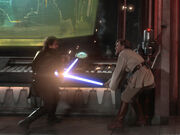
Darth Vader and his master, Obi-Wan Kenobi, battle on Mustafar.
The duel is shorter than it is in the movie, as the novel focuses more on the duelers' emotions rather than on the details of the battle itself. The book has addressed the famous "Obi-Wan's interchanging lightsaber" issue when he was choked by Vader. The way Vader loses his limbs is the same, but the dialogue is reversed from "I Hate You," followed by "You were my brother Anakin, I loved you" to having Obi-Wan speak first.
The feelings of Vader

Darth Vader's mask being lowered into place.
In the book, we learn more about the feelings of Anakin as he is locked into the armor, both his feelings about the suit itself, as well as his feelings about other recent events: his feelings for certain people (e.g. Padmé and Obi-Wan), his anger towards Obi-Wan for trying to turn Padmé herself against him, and his anger at Obi-Wan leaving him to die. While the film gives the audience a glimpse of Anakin/Vader's feelings about the death of his wife, the book shows such things in more depth, and shows his regret, his disbelief and his sorrow at losing not only his wife, but his child.
Darth Vader, deprived of everything, save his loyalty to his master.
Next generation
Next in sequence of the book happens to be the birth of the Skywalkers and other matters. Little was changed in the ending in the novelization, although more was revealed about Yoda's thoughts of what went wrong with the Jedi Order and his ability to communicate with a deceased Qui-Gon Jinn.
Canonicity
Though all novelizations are C-canon by default, one may wish to consider the following statement from Matthew Stover before writing anything off as an "inconsistency":
| Source: [1] | |
|
Though I did not personally watch him do it, I received from LFL a Word document of Revenge of the Sith with Mr Lucas' edits, which was distinct from the edits I'd already gotten from Sue Rostoni and Howard Roffman and the rest of the LFL crew, and this document was edited in such a detailed fashion that even individual words had been struck off and his preferred replacements inserted, as well as some passages wholly excised and some dialogue replaced with the dialogue from the screenplay. If that's not line-editing, I don't know what is. What's in that book is there because Mr. Lucas wanted it to be there. What's not in that book is not there because Mr. Lucas wanted it gone. Period. | |
Appearances
Characters
- Ask Aak
- Stass Allie
- Mas Amedda
- Padmé Amidala
- Luke Skywalker (infant)
- Leia Amidala Skywalker, or/later Leia Organa Solo (infant)
- Darth Bane (Mentioned only)
- Depa Billaba (Mentioned only)
- Garm Bel Iblis (Mentioned only)
- Bana Breemu
- Sora Bulq (Mentioned only)
- Cody
- Giddean Danu
- Count Dooku
- Tundra Dowmeia
- Chi Eekway
- Ellé
- Jango Fett (Mentioned only)
- Grievous
- Nute Gunray
- Rune Haako
- San Hill
- Jurokk
- Obi-Wan Kenobi
- Agen Kolar
- Plo Koon
- Cliegg Lars (Mentioned only)
- Shu Mai
- Whie Malreaux
- Sly Moore
- Moteé
- Mon Mothma
- Lorian Nod (Mentioned only)
- Bail Organa
- Palpatine
- Sate Pestage
- Darth Plagueis (Mentioned only)
- Oppo Rancisis
- Raith Sienar (Mentioned only)
- Anakin Skywalker
- Wat Tambor
- Terr Taneel
- Wilhuff Tarkin
- Shaak Ti
- Saesee Tiin
- Tarka-Null
- Captain Typho
- Unnamed Shaman of the Whills (Mentioned only)
- Mace Windu
- Watto (Mentioned only)
- Yoda
- Fang Zar
- Durge (Mentioned only)
Creatures
- Dewback (Mentioned only)
- Eopie
- Gualaar
- Jerba (Mentioned only)
- Rancor (Mentioned only)
- Sarlacc (Mentioned only)
- Varactyl
Droids
Languages
Locations
- Ando (Mentioned only)
- Coruscant
- Geonosis (Mentioned only)
- Haruun Kal (Mentioned only)
- Kashyyyk (Mentioned only)
- Mon Calamari (Mentioned only)
- Jabiim (Mentioned only)
- Mustafar
- Naboo
- Nar Shaddaa (Mentioned only)
- Ord Mantell
- Polis Massa
- Tatooine
- Jundland Wastes
- Mos Espa (Mentioned only)
- Utapau
- Ywllandr system
Organizations and titles
- Ancient Order of the Whills (Mentioned only)
- Shaman of the Whills (Mentioned only)
- Confederacy of Independent Systems
- Galactic Republic
Species
- Chalactan (Mentioned only)
- Ferroan (Mentioned only)
- Gamorrean (Mentioned only)
- Human
- Kaleesh
- Utapaun
- Whill (Mentioned only)
- Wookiee
- Zabrak
Vehicles and vessels
- Aggressive ReConnaissance-170 starfighter
- All Terrain Scout Transport
- Providence-class carrier/destroyer
Weapons and technology
Miscellenea
- Dejarik
- Duranium
- Durasteel
- Chosen one
- Corusca Gem (Mentioned only)
- The Force
- Form IV: Ataru
- Form VII: Vaapad
- Japor snippet
- Japor ivory wood
- Scramball
- Shuura
- Transparisteel
- Wroshyr tree
Collections
Cover gallery
This is a gallery of the different cover variations of the Star Wars Episode III: Revenge of the Sith novelization.
External links
- Cargo Bay entry
 Episode III Author Announced on StarWars.com (backup link (episode-iii/release/publishing/news20031114.html) not verified!)
Episode III Author Announced on StarWars.com (backup link (episode-iii/release/publishing/news20031114.html) not verified!) Homing Beacon #100 - Ep III Novel: First Steps on StarWars.com (backup link (episode-iii/release/publishing/beacon100.html) not verified!)
Homing Beacon #100 - Ep III Novel: First Steps on StarWars.com (backup link (episode-iii/release/publishing/beacon100.html) not verified!) Planning Your Episode III Bookshelf on StarWars.com (backup link (episode-iii/release/publishing/news20041124.html) not verified!)
Planning Your Episode III Bookshelf on StarWars.com (backup link (episode-iii/release/publishing/news20041124.html) not verified!) Final Covers: Episode III Books on StarWars.com (backup link (episode-iii/release/publishing/news20050114.html) not verified!)
Final Covers: Episode III Books on StarWars.com (backup link (episode-iii/release/publishing/news20050114.html) not verified!) Inside Del Rey's Episode III Library on StarWars.com (backup link (episode-iii/release/publishing/f20050330/index.html) not verified!)
Inside Del Rey's Episode III Library on StarWars.com (backup link (episode-iii/release/publishing/f20050330/index.html) not verified!) Interview with Matthew Stover video on StarWars.com (backup link (episode-iii/release/publishing/stover.html) not verified!)
Interview with Matthew Stover video on StarWars.com (backup link (episode-iii/release/publishing/stover.html) not verified!) Revenge and Labyrinth Omnibus Coming Soon on StarWars.com (backup link (episode-iii/release/publishing/news20050603.html) not verified!)
Revenge and Labyrinth Omnibus Coming Soon on StarWars.com (backup link (episode-iii/release/publishing/news20050603.html) not verified!)- Fan site discussing the EU elements of the novel


